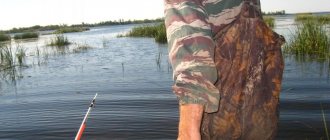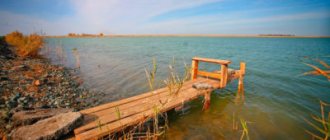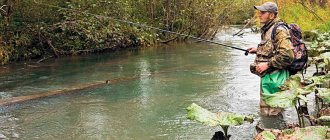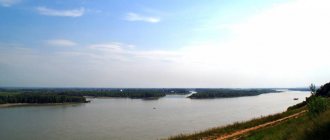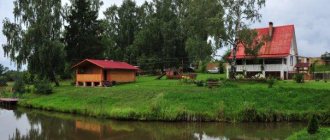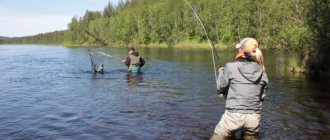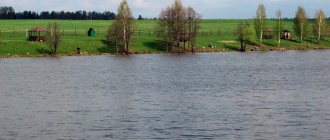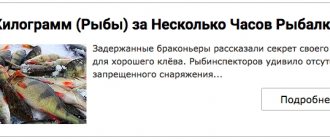Reservoirs of the Omsk region
Fishing places in the Omsk region
Lakes in the Omsk region number 16 thousand fresh and 4 thousand salt water bodies. A landmark of the Omsk region is the salt lake Ebeity, which is famous for its healing power. This is the largest lake in the region, the mud of which is used in Omsk sanatoriums to treat many diseases. Not far from Ebeyta there is a freshwater lake called Amrinskaya Balka, which attracts lovers of fishing and active recreation. This lake has the status of a regional natural monument.
Fishing in the Omsk region is very widespread due to the huge number of lakes rich in fish. There are lakes in the region where tourist centers are located and paid fishing is organized. These are lakes Linevo and Danilovo. And there are lakes where you can come as a savage. For example, lakes Bitiya, Verblyuzhye, Tobol-Kushly, Saltaim. Fishing in the region's reservoirs is rich in catches of fish such as crucian carp, chebak, bream, burbot, peled, pike perch, nelma, pike, perch, carp, bream, ruffe and others. Fishing is limited to only one month from April 20 to May 20. Fishing is possible throughout the region, subject to certain rules established by law. There are fish listed in the Red Book and prohibited from catching; it is better to release them into the reservoir.
The best places for fishing are:
- The Irtysh River near the village of Novoomsk is the most catchable place where you can catch crucian carp or ruffe. Fishing is done both from the shore and from a boat;
- You can catch crucian carp, carp, pike and perch on the Irtysh near the village of Krasnoyarka. You can fish here both on the shore and on a boat. You can cook fish on prepared grill areas. The Kolos sanatorium is located nearby;
- There is another fishing place in the Omsk region - the Om River near a village called Kormilovka. But here you can only catch carp and crucian carp. Therefore, this is a real haven for those who like to fish with a spring or feeder from a boat or shore;
- Uvalnaya Bitiya is a village next to which Lake Zhiloye is located, where predatory fish are found: perch and pike;
- Lake Ik, which is located near the village of Kiterma, is famous for its excellent fishing for crucian carp. This lake is 12 kilometers long and 8 kilometers wide. The bottom of the lake is very flat, it is completely covered with silt deposits. There are no other fish except crucian carp here;
- Lake Linevo is located far from populated areas in the Muromtsevo region. The nearest settlement is the village of Nadezhkino. Fishing here is for roach, tench, bream, pike and perch;
- In the Muromtsevo district of the Omsk region there is another large lake: Shchuchye. It is located closer to the village of Nadezhkino, but not far away there is a paid fishing base, named after the lake mentioned above - Linevo. Here you can catch pike, perch, roach, tench and bream;
- Particular attention should be paid to Lake Danilovo, which very much resembles a mountain reservoir. Its depth is 17 meters, and the water in it is so clear that you can see the bottom of the lake if it is no deeper than 5 meters. Aspen, birch, and pine trees grow along the banks of the reservoir. But there is no aquatic vegetation in the lake itself. Here you can catch carp and crucian carp, as well as chebak, pike and perch. Near the lake there is a village called Kurganka;
- In the Znamensky district, near the village of Ust-Shish, located 400 kilometers from Omsk, there is the Shish River, in whose waters ide, roach, pike and perch are found. The depth of the river is 15 meters. This taiga river has a very winding channel.
All reservoirs have a certain status - either it is publicly accessible or leased. For recreational fishing, fishing in publicly accessible water bodies is free, but fishing in leased water bodies may be subject to a fee. Once you know the status of the reservoir, you can safely go fishing. Before fishing, you must familiarize yourself with the rules of fishing in the Omsk region in advance.
Map of fishing spots
In winter, crowds of fishermen can be seen on the Novoomsky backwater. Definitely, they went in search of peaceful fish, armed with a jig. This is one of the region's most popular ice fishing spots. The bottom is mostly sandy, but sometimes there are areas covered with silt. The depth of the reservoir does not exceed 5 meters.
An excellent place for active recreation and fishing is Amrinskaya Balka. This is a universal place where you can go fishing, go pick mushrooms or berries, or just admire nature. Local residents often relax in this place. The clean clay bottom and shallow depth (about two meters) make this reservoir an ideal place for fishing.
Platovskaya Balka attracts fishermen from everywhere at any time of the day and at any time of the year. And this is no longer surprising, since the reservoir is an attractive place for fishing. Local and visiting fishermen constantly occupy almost all places suitable for fishing. It is best to use a jig as bait, both in winter and spring. The depth of the reservoir does not exceed three meters, and the bottom is covered with a thick layer of silt.
Lake Kadal, although surrounded by steppe, hides good specimens of fish under its water. However, due to the location, the wind constantly blows here, so the place is only suitable for fishing from a boat. A rocky and sometimes sandy bottom with a depth of about 1-2 meters covers promising areas for fishing.
We suggest you familiarize yourself with: Twister for fishing
Features of fishing in the region
The Omsk region is famous for its reservoirs, which are home to dozens of species of fish. Therefore, fishing is a favorite type of recreation among both local residents and visiting tourists. Travel companies, hunting and fishing centers offer delivery to reservoirs and “fishing spots” by any means of transport, at any time of the year. Here tourists can be offered fishing equipment for rent and advice from an experienced fisherman-instructor. The rivers and lakes of the region are inhabited by grayling, gudgeon, lenok, ruffe, whitefish, roach, muksun, pike, bream, ide, carp, two types of crucian carp (silver and gold), pike perch, burbot, and perch. Crayfish live in some reservoirs with clean, clear water.
Very rarely, Siberian sturgeon and nelma can become prey for fishermen. These species are considered endangered (endangered) and such catch should be immediately released back. Among the permitted fishing means, it is allowed to use a float rod, bottom rod, or spinning rod.
All rivers belong to the Irtysh River basin, which flows from south to north, then turns northwest and crosses the region. The length of this large Siberian river across the region is 1,132 kilometers. Many rivers flow into the Irtysh, but its largest and deepest tributaries are the Uy, Om, Shish, Tara, Tui, Ishim and Osha. A large number of rivers and streams also flow into the tributaries. There are a total of 4,230 rivers in the region.
The Omsk region is famous for its numerous, environmentally friendly lakes; there are more than 16 thousand fresh lakes and almost 4 thousand salt lakes, with varying degrees of water mineralization. In the northern half of the region, overgrown with coniferous taiga and covered with swamps, there are lakes with fresh water. Salt lakes are located in the southern part of the region, among small-leaved forests and steppes. The middle, flat part of the region is characterized by low hills and elongated ridges 1-3 km wide and up to 20-25 km long. The shores of the lakes are overgrown with steppe grass, reeds and bushes. There are also fresh lakes in the middle and southern parts of the region.
Twenty-five lakes have a water surface area of more than 10 hectares, and the area of the four largest lakes (Ebeity, Tenis, Saltaim and Ik) is up to 50 square kilometers. Lakes differ from each other in water transparency. In some lakes the water is crystal clear (for example, in Danilovskoye). But in most lakes, the water has a brownish tint due to the presence of clay particles and silt.
Most rivers and lakes in the region are available for free recreational fishing. Among fishermen, “secret” information about fishing spots and reservoirs where a very good bite awaits is passed on from mouth to mouth. These are many secluded places on the Irtysh, the Achaikha River, which is only 30 km long, and which can be passed by boat in a day, and the artificial lake Amrinskaya Balka. In these reservoirs, large crucian carp and pike, roach, ruffe, and perch are excellently caught. Pike perch is excellently caught on large fresh lakes - Ika, Tennis and Saltaim. Ide lives in abundance in the small and narrow river Ust-Shish. The depth of this river in the lower reaches reaches 14-15 meters.
On small lakes and artificial ponds in the region, fish farms breed golden and silver carp, sturgeon, silver carp and crucian carp.
These reservoirs are also home to carp, small pike and perch. Here, paid fishing is available for amateurs; payment is taken for access to the reservoir and per kilogram of catch. There are more than a dozen such reservoirs - ponds in the villages of Azovo, Karpovka, Irtyshsky, Kharlamovo, Pad, Popovka. Far from populated areas there are Kokorinsky ponds, the Novoivanovskoe fish farm, the fish farm “Fish Place”, an artificial pond between the villages of Sosnovka and Novoomsky, a reservoir on the territory of Omsk State Agrarian University, an artificial lake Amrinskaya Balka, a pit pond at the exit from Omsk (Vorovskogo St.), base "Cool Lake". Paid fishing spots are fully equipped for the recreation of amateur fishermen and tourists. You can come here on vacation with the whole family. Fishing in the Omsk region
Starting from the beginning of November, freeze-up begins on the reservoirs of the region. Already in mid-December, the ice everywhere becomes strong enough to go out on it, drill a hole and try your luck at ice fishing. By the end of winter, the thickness of the ice shell on reservoirs reaches one meter or more. Ice fishing in the region is less popular than summer fishing, the reason for this is low temperatures, from minus 20 to minus 35 degrees, which, with rare thaws, last throughout the winter. However, a few winter fishing enthusiasts constantly go to water bodies. Their catch most often is perch and roach, but with a winter fishing rod you can catch any fish that lives in the reservoir.
Fishing on the Irtysh
The Irtysh River is an important component of the city of Omsk and the entire region. From April to early November, the Irtysh becomes a navigable river. But by mid-November it is covered with ice, which lasts until April.
Fishing in the Irtysh is carried out both in summer and winter, almost without interruption, except for spawning bans. The river ichthyofauna of the Irtysh is very diverse and rich. Representatives of salmon, sturgeon, carp, perch, cod, and pike species live in the waters of this great river.
As for the size of the fish in the catch, it all depends on the skill of the fisherman and his knowledge of the river and the habits of various fish. Some have to catch fish that are not too large, while others can catch real trophy specimens. The catches can include small perch, roach or bream, as well as large pike, catfish or carp.
Summer fishing on the Irtysh in the Omsk region is very productive and catchy. The Irtysh, in the summer, is an excellent place for relaxation and unity with nature. An excellent opportunity for night fishing and fishing in the morning dawns. At the same time, fishing on the Irtysh in summer has many advantages. You can go to the river with friends or with the whole family, enjoy aromatic fish soup from fresh fish, or bake fish over coals in the grill. Such moments are not forgotten for a long time.
One of the key points of fishing is the selection of the necessary attachments and baits, the preparation of bait and the correct feeding of the fishing point. After all, the success of fishing and the size of the catch will largely depend on this. Bait and attachment can be very different, these include maggots and earthworms and caddis larvae and many other insects and their larvae. As for baits, they are also traditional for catching peaceful fish, this is bread crumb. Steamed pearl barley or peas, boiled potatoes, semolina, corn and much more. For example, if the best bait for catching carp is boiled potatoes, then semolina is the best bait for silver carp, and a worm or bread for crucian carp.
However, do not forget that it is better to serve the fish with a bait with a fragrant smell, and it should definitely look more appetizing than groundbait.
Otherwise, the fish will simply be satisfied with the bait and will not pay attention to the bait at all. Fishing in Omsk
Successful fishing on the Irtysh in Omsk largely depends on proper baiting of fishing spots. The bait can be either special branded bait intended for a specific type of fish, or homemade based on various cereals, peas, corn, sunflower cake, mixed feed or crackers.
It is very interesting for fishermen to feed fishing points during the non-biting period. It's hard to believe, but they throw non-branded bait into the water. Or a mixture based on cereals and other food ingredients, and a decoction of large pieces of red brick and various greens. This “bait” miraculously attracts roach, bream, silver bream, rudd and other fish. Moreover, the bite in such a place lasts not one or two days, but 2-3 weeks! And such fishing on the Irtysh in Omsk brings very rich catches.
There are many well-tested and reliable recipes for such “brick” baits. And they are all prepared according to the same principle. Pieces of brick or a whole brick are boiled for about 5 hours, and every hour in the container where the brick is boiled, the greens, garlic, wormwood, dill, currants, ferns, raspberries and other herbs, and leaves of bushes are changed. Next, the brick boiled in this way is coated with sunflower oil. This bait can be used several times. To do this, pieces of brick can be removed from the water and wrapped in cellophane bags. If an angler constantly fishes in the same place, then he boils several bricks at once, and then lays them out at different depths while fishing. Thus, you can even prepare a place for winter fishing.
Fishing in Omsk on the Irtysh in spring is also very remarkable. Bream and other white fish are caught especially well at this time. Burbot is also well caught in the Irtysh in spring. To successfully fish for burbot, anglers go fishing in the evening and return home in the morning with decent catches.
The fish likes to hide in snags and underwater bushes, and anglers take this into account when feeding fishing points. When it is a clear and fine day, the bite, as a rule, begins from the very early morning. But if the weather is cloudy, then the bite is often guaranteed throughout the day.
Types of fish in the Irtysh
Fishing in the Irtysh in the Omsk region is carried out for a wide variety of fish. The ichthyofauna of this river is very diverse: Siberian sturgeon, carp, bream, crucian carp, carp, Siberian vendace, nelma, pike perch, ide, burbot, pike, perch, whitefish and others.
The most popular places for fishing on the Irtysh in the vicinity of Omsk are Rybachye, Nikolaevka, the territory of the ship repair yard, Beregovoe, Lake Cheredovoe, and the Supgutskaya base.
The Irtysh in Omsk will attract fishing for large pike, carp and grass carp. But there are not many fish like crucian carp, perch or silver carp here. However, these types of fish live in abundance in the reservoirs of the Muromtsevo region. First of all, it is recommended to visit the Artyn fishing base, which is located on the Artynka River, and reservoirs in the village of Kostino. These places abound with large crucian carp. On the Tara River and in lakes Danilovo, Shchuchye, Linevo, there are a lot of chebak, bream and perch. Fishing on the Irtysh River
One of the fish tributaries of the Irtysh is the Om River, it flows through 4 Omsk districts. However, from the point of view of local fishermen, the richest area in fish is the Kormilovsky district. Here you have the highest chance of getting significant catches of ide, carp, chebak, tench and crucian carp. On the left tributary of the Irtysh, the Osha River, large crucian carp are excellently caught.
Due to the fact that for a number of reasons (poaching, water pollution, etc.) there are fewer and fewer Siberian sturgeon and sterlet in the Irtysh, the rules for catching this fish have been tightened. Thus, due to poaching, up to 50 tons of sterlet are caught annually in the waters of the Irtysh. And only 3-4% of this fish ends up spawning. Therefore, catching this fish is only possible under licenses.
Fishing on Lake Ik
Lake Ik is located in the north-west of the Omsk region, 53 km from the railway. Stations. In the vicinity of the village of Krutinki, the lake looks like a narrow strait, and then widens to about 1 km, and Lake Ik ends near the village of Kalachiki, 8 km from its beginning to the north. There are good approaches to the lake shore and fishing from the shore is very convenient. The shores around the lake are very beautiful and picturesque.
In summer, the banks are covered with carpets of bright, beautiful vegetation with numerous flowers, from which an amazing aroma emanates. The lake has many shallows where fish like to feed and deep holes where predators often lurk. The lake abounds in large perch; it is perch that is primarily used for fishing in the Omsk region on Lake Ik.
It is very interesting to catch perch in a reservoir in the summer, but the highlight of this lake is winter fishing for perch. Local fishermen, going fishing on Lake Ik for several days, came up with an ingenious way to protect themselves from the steppe winds that rage in the “snow houses” in the middle of winter. They are a free alternative to modern fishing tents. But snow houses have been built since time immemorial.
Experienced fishermen place such houses only at the most catchy holes. It is not difficult to build such a house. At the beginning of winter, when thaws are not uncommon and a strong snow crust forms on the snow, pieces like slabs are cut out of the snow with a wooden or iron shovel. 3 walls are laid out of such snow slabs around the fishing holes, the height of which should hide the fisherman’s head. Snow houses are not built higher, as they will quickly collapse. The entrance to such a house is always on the south side. Walls can also be made from ordinary snow, pouring water on them in mild frosts. They try to build the walls in a streamlined shape; they can better withstand strong gusty winds and are more stable. Many people equip their houses with special ledges for sitting, on which cotton wool mattresses are laid.
Local fishermen also have an unwritten rule not to occupy other people’s houses. Many anglers have 6-10 permanent holes. When fish are not caught from it, in order to avoid freezing, the hole is covered with a thick layer of snow.
Quite often, local fishermen go out on the lake with the whole family.
Among fishing enthusiasts there are people of various specialties, young and old, men and women. On such trips they take with them dogs, huskies, mongrels, in a word, whatever they have, they are harnessed to light sleighs. They go to the lake empty, and bring back sleighs full of frozen perch. Fishing on Lake Ik
They fish with ordinary winter fishing rods with a reel and a nod, a line no thicker than 0.2 mm in diameter, they use jigs, shot from an alloy of tin and lead, and jigs (amphipods) are used as bait. The working depth is approximately 3 meters, a little more in some places, a little less in others. The quality and quantity of the catch depends on the ability to play with a jig. Frequent bites are felt well, the perch, as usual, takes correctly and greedily.
But fishing in the Omsk region for perch in the waters of Lake Ik is carried out using a homemade spoon made of silver or brass, which is handmade by local craftsmen. These baits are called samolov spinners; no bait is required for such a bait; fish are attracted by the shine of the copper wire and the bait itself. The largest specimens of perch are caught with this bait.
And although, as a rule, large specimens are caught on lures, many fishermen still prefer fishing for perch in the Omsk region on Lake Ik with jigs. Bites occur much more often, landing fish is more interesting, and besides, large perch often bite on the jig. True, due to the thin equipment, breaks occur, but this does not upset the fishermen, but only adds additional excitement to fishing.
Local fishermen store their catch in a very original way. Many people set up special “storerooms” made of ice near the holes, and fish from these storerooms are transported home on dog sleds. From part of the catch, fish soup is boiled or fish is fried over a fire in frying pans or baked in coals, and the main catch is sent to the pantry.
Fishermen equip such winter storerooms in January and use them until the end of April. They are equipped in this way: a niche of arbitrary size is cut out in the thickness of the ice, and the entrance to the storeroom is made from the north side. Such a catch can be stored in a storage room from several days to 1-2 weeks, depending on how long the fisherman stays on the lake.
Winter fishing on Lake Ik in the Omsk region is an excellent opportunity to enjoy catching large perch and spend time surrounded by the harsh but beautiful Siberian nature.
Irtysh
Undoubtedly, the most famous and popular among fishermen is the mighty Irtysh River. Weather conditions in the region provide the opportunity to fish in comfort not only in summer, but also in cold weather, when the water is covered with a thick layer of ice. There are now over 20 species of fish in high water. It should be noted that recently the population of certain species has been increased artificially, and the fishing of certain species has been banned.
It must be said that the Irtysh is a favorite place for athletes who come from all over Russia to enjoy the picturesque landscapes and catch a trophy fish. This, in turn, attracts many fans. Along the entire coastline of the River there are a huge number of fishing bases, as well as beautiful and cozy places to relax with friends or family.
Most of the bases provide all the gear necessary for fishing for a fee; this is an advantage for a family vacation, since you usually have a lot of things with you and nowhere to put extra gear. By the way, any beginner has the opportunity to go fishing with a guide to gain experience and learn all the nuances.
Among the main nuances of fishing on the Irtysh is the ban on catching salmon, tench or muksun. Only those who have special permission can remove the above-mentioned specimens from the reservoir. Otherwise, an administrative fine may be imposed on the fisherman.
see also
|
|
|
